Roma Termini railway station
Roma Termini | |
|---|---|
|
| |
| Location |
Piazzale dei Cinquecento 00185 Rome Italy |
| Coordinates | 41°54′03″N 12°30′07″E / 41.90083°N 12.50194°ECoordinates: 41°54′03″N 12°30′07″E / 41.90083°N 12.50194°E |
| Operated by | Grandi Stazioni |
| Line(s) |
|
| Platforms | 32 |
| Connections |
|
| History | |
| Opened | 1862 |
| Location | |
 Roma Termini Location within Rome | |
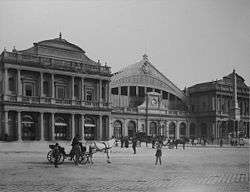
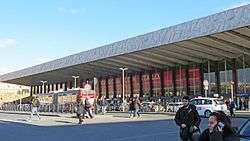
(Feb 2017)
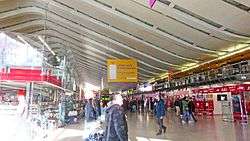
(Feb 2017)
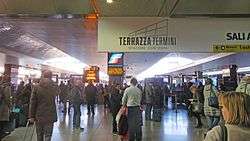
(Feb 2017)
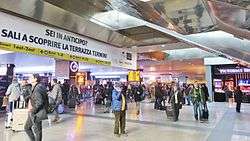
(Feb 2017)
Roma Termini (in Italian, Stazione Termini) is the main railway station of Rome, Italy. It is named after the district of the same name, which in turn took its name from ancient Baths of Diocletian (in Latin, thermae), which lie across the street from the main entrance.[1]
Overview
The station has regular train services to all major Italian cities, as well as daily international services to Munich, Geneva, and Vienna. With 33 platforms and over 150 million passengers each year,[2] Roma Termini is the second largest railway station in Europe after Paris Gare du Nord.
Termini is also the main hub for public transport inside Rome. Two Rome Metro lines (A and B) intersect at Termini metro station, and a major bus station is located at Piazza dei Cinquecento, the square in front of the station. However, the main tram lines of the city cross at Porta Maggiore, some 1,500 metres east of the station.
On 23 December 2006, the station was dedicated to Pope John Paul II.[2]
History
On 25 February 1863, Pope Pius IX opened the first, temporary Termini Station as the terminus of the Rome–Frascati, Rome–Civitavecchia and Rome-Ceprano lines.
The first two lines previously had separate stations elsewhere in the city, and, as the third line was under development, the city chose to build one central station, as opposed to the Paris model of having separate terminus stations for each line or each direction. The dilapidated Villa Montalto-Peretti, erected in the 16th Century by Pope Sixtus V, was chosen as the site for this new station, which was to be called the "Stazione Centrale delle Ferrovie Romane" (Central Station of Roman Railways).
Construction of the permanent station began in 1868, in the last years of the Papal Temporal Power over the city of Rome, and was completed in 1874 after the Capture of Rome and installing of government of United Italy. It was laid out according to a plan by the architect Salvatore Bianchi. The front of this station reached Via Cavour, which means it extended some 200 metres deeper into the city than the current station.
In 1937, it was decided to replace the old station, as part of the planning for the 1942 World's Fair, which was never held because of the outbreak of World War II. The old station was demolished, and part of the new station was constructed, but works were halted in 1943 as the Italian fascist government collapsed. The side structures of the design by Angiolo Mazzoni del Grande are still part of the current-day station.
The terminal building today
The current building was designed by the two teams selected through a competition in 1947: Leo Calini and Eugenio Montuori; Massimo Castellazzi, Vasco Fadigati, Achille Pintonello and Annibale Vitellozzi. It was inaugurated in 1950. The building is characterized by the linear lobby hall, a tall space of monumental dimensions. This great hall is fronted by full height glass walls, and is covered with a concrete roof that consists of a flattened and segmented arch, a modernist version of a barrel vault from a Roman bath. The vault is structurally integrated with a cantilevered canopy that extends over the entrance drive. The end result is a gravity-defying modernist structure that also recalls a similar achievement of Roman architecture. The back of the hall leads to a transition space of ticketing functions before reaching the train shed, and is topped by an even longer building block that houses a 10-story hotel, clad with travertine.
Architecturally, the building punctuates the sense of arrival to Rome, and communicates a sense of the Eternal City as both modern and traditional, looking forward to the future as well as remembering its history. Its bold presence in the urban fabric expresses the diversity of the City's history, and speaks of the dramatic new scale of the modern industrial economy of Italy.
The anodized aluminium frieze panels set in sequence along the length of the glass wall are the work of artist Amerigo Tot. The composition is about capturing the dynamics in sound and speed of a train.
Servian Walls
A length of the early Roman Servian Wall is preserved outside the station.
Services












Interchanges




Train services
The station is served by the following services (incomplete):
- High speed services (Frecciarossa) Turin - Milan - Bologna - Florence - Rome - Naples - Salerno
- High speed services (Italo) Turin - Milan - Bologna - Florence - Rome - Naples - Salerno
- High speed services (Frecciarossa) Venice - Padua - Bologna - Florence - Rome - Naples - Salerno
- High speed services (Italo) Venice - Padua - Bologna - Florence - Rome
- High speed services (Frecciargento) Trieste - Venice - Padua - Bologna - Florence - Rome
- High speed services (Frecciargento) Venice - Padua - Bologna - Florence - Rome
- High speed services (Frecciargento) Venice - Padua - Bologna - Florence - Rome - Fiumicino Airport
- High speed services (Frecciargento) Udine - Treviso - Venice - Padua - Bologna - Florence - Rome
- High speed services (Frecciargento) Bolzano/Bozen - Verona - Bologna - Florence - Rome
- High speed services (Frecciargento) Brescia - Verona - Bologna - Florence - Rome
- High speed services (italo) Brescia - Verona - Bologna - Florence - Rome - Naples
- High speed services (Frecciargento) Rome - Foggia - Bari - Brindisi - Lecce
- High speed services (Frecciargento) Rome - Naples - Salerno - Lamezia Terme - Reggio di Calabria
- High speed services (Frecciabianca) Turin - Genoa - La Spezia - Pisa - Livorno - Rome
- High speed services (Frecciabianca) Milan - Genoa - La Spezia - Pisa - Florence - Rome
- High speed services (Frecciabianca) Ravenna - Rimini - Foligno - Terni - Rome
- High speed services (Frecciabianca) Rome - Naples - Salerno - Lamezia Terme - Reggio di Calabria
- Intercity services Rome - Naples - Salerno - Lamezia Terme - Messina - Palermo / Siracusa
- Intercity services Rome - Naples - Salerno - Lamezia Terme - Reggio di Calabria
- Intercity services Rome - Naples - Salerno - Taranto
- Intercity services Rome - Foggia - Bari (- Taranto)
- Intercity services Ventimiglia - Genoa - La Spezia - Pisa - Livorno - Rome
- Intercity services Turin - Genoa - La Spezia - Pisa - Livorno - Rome - Naples - Salerno
- Intercity services Livorno - Civitavecchia - Rome - Naples
- Intercity services Trieste - Venice - Padua - Bologna - Florence - Rome
- Intercity services Ancona - Foligno - Terni - Rome
- Intercity services Perugia - Foligno - Terni - Rome
- Night train (EuroNight) Vienna - Klagenfurt - Villach - Venice - Bologna - Florence - Rome
- Night train (CityNightLine) Munich - Wörgl - Innsbruck - Verona - Bologna - Florence - Rome
- Night train (Intercity Notte) Trieste - Udine - Treviso - Venice - Padua - Bologna - Rome
- Night train (Intercity Notte) Bolzano/Bozen - Verona - Rome
- Night train (Intercity Notte) Rome - Foggia - Bari - Brindisi - Lecce
- Night train (Intercity Notte) Rome - Naples - Messina - Palermo / Siracusa
- Regional services (Leonardo Express) Rome - Fiumicino Airport
- Regional services (Treno Regionale) Rome - Pomezia - Latina - Formia - Minturno - Naples
- Regional services (Treno Regionale) Rome - Pomezia - Nettuno
- Regional services (Treno Regionale) Rome - Venafro - Campobasso
- Regional services (Treno Regionale) Rome - Ciampino - Zagarolo - Collefero - Frosinone
- Regional services (Treno Regionale) Rome - Ciampino - Albano Laziale
- Regional services (Treno Regionale) Rome - Ciampino - Velletri
- Regional services (Treno Regionale) Civitavecchia - Cerveteri - Rome
In popular culture
- Stazione Termini (1953)
- Indiscretion of an American Wife (1954)
See also
- History of rail transport in Italy
- List of railway stations in Lazio
- Rail transport in Italy
- Railway stations in Italy
- Roma Ostiense railway station, the third-largest station in Rome
- Roma Tiburtina railway station, the second-largest station in Rome
References
- ↑ Guida d'Italia. Roma. Milan: Touring Club Italiano. 1999. p. 162. : "il toponimo deriva dalle terme di Diocleziano" ("the toponym derives from the Baths of Diocletian").
- 1 2 Roma Termini
External links
| Wikimedia Commons has media related to Roma Termini railway station. |